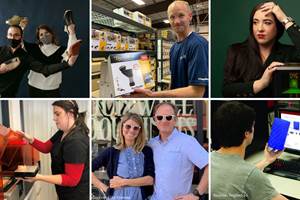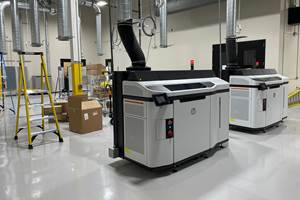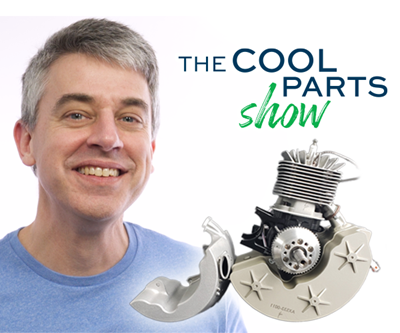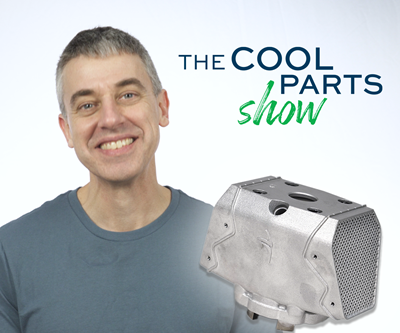New Electric Dirt Bike Is Designed for Molding, but Produced Through 3D Printing (Includes Video)
Cobra Moto’s new all-electric youth motocross bike could not wait for mold tooling. Parts have been designed so they can be molded eventually, but to get the bike to market, the production method now is additive manufacturing.
Share
Sean Hilbert, president of Cobra Moto, says manufacturers make a mistake in the way they justify additive manufacturing capability. “We cost it wrong,” he says.
If the expense of a production AM system is amortized across the parts it produces — the typical way to account for production capital equipment — then the unit cost of each 3D printed component is apt to be high. Additive manufacturing is often subject to bursts of activity, producing parts as they are needed.
But if the manufacturer accepts that AM is a necessary in-house capability for responding quickly to new opportunities and changing market needs, then the capability is an overhead cost. That is, it is a cost of doing business as a modern manufacturer, and the parts made with this capability are simply this quick response put into practice. That is Hilbert’s view, and this very advantage of AM has allowed his company to seize a new market opportunity a year or more earlier than it might have been able to if conventional manufacturing was the only option.
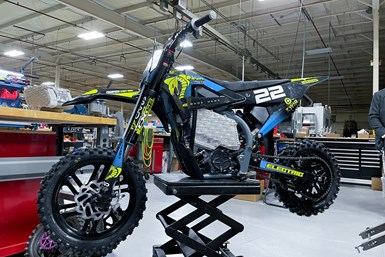
The new all-electric motorcycle from Cobra Moto achieves the speed and performance of the company's previous dirt bike models, just without internal combustion. Various components are manufactured through 3D printing.
Based in Hillsdale, Michigan, Cobra Moto makes youth dirt bikes, including those used by young motocross competitors. Moving into production quickly proved vital to this year’s launch of an entirely new offering for the company: its first all-electric dirt bike. Cobra’s first departure from gas-powered motorcycles required numerous new components to be designed, many of which are now being manufactured through 3D printing even though they are fully suitable for injection molding. Indeed, the components in question have all been designed for injection molding — not for additive manufacturing. And in the future, they will be molded. But for Cobra to obtain all the mold tooling needed to go into full production with this bike, given the lead times it currently faces from its mold suppliers, might require a year or more, says Hilbert. Additive manufacturing allows the bike to be launched without this wait. Components will be made more cheaply through molding starting sometime next year or the year after, but right now, the chance to begin selling the new electric motorcycle is invaluable.
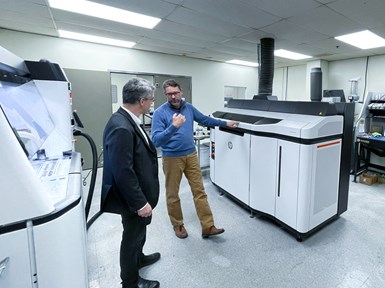
Cobra Moto's president Sean Hilbert (in blue, talking to Peter Zelinski) sees additive manufacturing capability as vital for introducing new products and responding to market demands quickly. The Multi Jet Fusion machine is seen here. Laser powder bed fusion is in a room behind him.
Or, most of these components will be made through molding. Not all, because molding is not a certainty, he says. In a case such as the bike’s throttle housing, which is a small component that can be run in batches of 200 within the build volume of the company’s HP Multi Jet Fusion (MJF) machine, this part might continue to be produced additively throughout the entire commercial and production lifetime of the bike. Additive manufacturing is a bridge to full-scale production, but it is also a very good option for the way that might be taken on the other side of that bridge.

Components of the new bike were designed for injection molding. They will be made that way eventually. For now, parts like this air diverter are being produced through 3D printing.
Bikes Are Not Like Drones
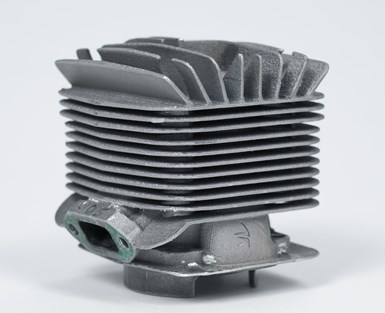
Sister company Cobra Aero applies AM to manufacturing unattended aerial vehicle engine parts. Two iterations of a 3D printed piston cylinder are seen in these images. In this one, the fin spacing is closer than casting could realize effectively.
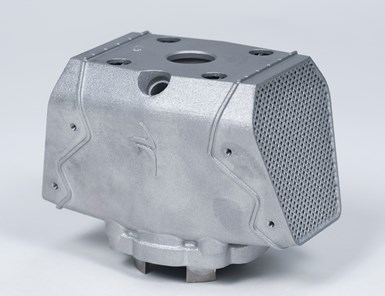
In this version of the cylinder, fins have been replaced by lattices made possible through AM. To learn much more about Cobra Aero's use of AM, see our episode of The Cool Parts Show about this cylinder, as well as our follow-up episode about an even more elaborate exhaust component.
The company is no stranger to additive. It has a sister company, which operates in the same facility and is also led by Hilbert: Cobra Aero, which serves the unmanned aerial vehicle (UAV) market with drone engines made through AM. For Cobra Aero, the use of additive allows for lightweight small-vehicle engines that take advantage of design possibilities including complex geometry in the form of close exterior fin spacing for improved cooling of pistons, as well as part consolidation and features printed inside the exhaust that control noise. “The UAV engines are a relatively high-price-point product made at low volumes, so additive manufacturing is just perfect as a production method,” Hilbert says. Metal and polymer components are made using, respectively, a laser powder bed fusion system from Renishaw and the MJF system from HP. On the UAV engines, parts are designed for additive manufacturing.
And that is the most significant difference in the use of additive between the two companies.
Cobra Moto has now begun to leverage and apply what Cobra Aero has learned about AM, but it is doing so to make parts that are not designed for AM. One by one, 3D printed components of the new electric bike will shift to molding as molds become available. The parts were designed with this destiny in mind. But first, something like 250 bikes will be made, sold and shipped with the parts made additively.
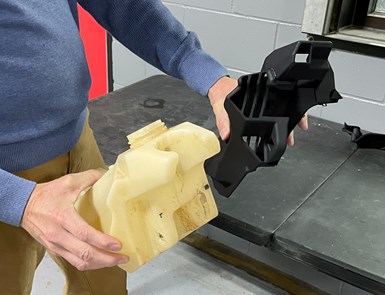
What appears to be an injection molded gas tank on the bike is really neither. This component of the bike is currently 3D printed rather than molded. It is made in two pieces that are joined by adhesive — a row of these assemblies is seen at the top of the page. Its purpose on the electric bike is to assist with airflow. Here, the fuel tank of a conventional dirt bike (the lighter colored part) is compared to the new electric bike component that copies its shape.
One of the bike’s most central components is a visible example. The bike’s “injection molded” “gas tank” is, in fact, neither. The faux gas tank on this electric vehicle (which needs no fuel tank) is actually a component that directs air to the control electronics for cooling. And though it was designed for molding and therefore resembles a molded part, it is being produced in PA12 polymer through MJF for now.
Other parts being made additively include the bike’s throttle housing (previously mentioned), plus the kill switch, air diverter, skid plate and motor cover. All are made through MJF, but that’s not the only printing process used. Battery separators that hold the bike’s power cells in place are being made through fused filament fabrication on a series of desktop 3D printers from Prusa — a hint at the range of platform options that might be applied to bridge production.

Three 3D printed parts are visible here, including the air diverter (1), skid plate (2) and motor cover (3).
The Design Can Still Change
Speed to market was invaluable for the new motorcycle because of the events where it might be ridden. “The motocross market revolves around a strict calendar of competitions,” says Hilbert. “If we miss a sale, we miss it forever.”
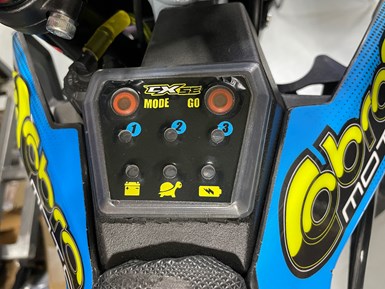
Electrification offers the opportunity for a different kind of experience of the motorcycle. Example: digital control settings enabling the performance of the bike to be set to the skill level of the rider.
But the timing is right in a larger sense as well. The value of electrification for youth motocross bikes is not so much fuel efficiency, as in the case of other electric vehicles, but instead is in the nature of the rider and buyer. An electric dirt bike is quiet; parents can allow their kids to ride on their own property (if there is room) without this being a nuisance. Safety and teaching are easier, because the digital control made possible by an electric motor allows the speed and power of the bike to be set at different levels for different riders’ skill levels. Plus, “We have a whole generation of younger parents who don’t know about the mechanical needs of bike maintenance,” Hilbert says. An electric bike is easier in this respect, as well.
Cobra Moto sells through dealers. Its top dealers were given a preview of the new electric offering earlier this year. They have begun promoting it. By the time this article appears, bikes will have shipped to some pre-order customers. And part of what will come from these sales, says Hilbert, is track experience. Real rider experience. That is, useful feedback — and with so many components made through AM, this feedback can be put to use.
“In the course of producing and shipping the first 250 or so units, we’ll discover areas for improvement. We’ll make design changes,” he says. The bike will get better because parts are being made with an adaptable process. Molding is definitely coming, which means hard tooling is coming. But because competitive riders are about to reveal how well the new bike and all its different parts perform, it is good that locking in the designs of all those molded parts can wait just a little while longer.
Related Content
8 Transformations 3D Printing Is Making Possible
Additive manufacturing changes every space it touches; progress can be tracked by looking for moments of transformation. Here are 8 places where 3D printing is enabling transformative change.
Read MoreWhat Does Additive Manufacturing Readiness Look Like?
The promise of distributed manufacturing is alluring, but to get there AM first needs to master scale production. GKN Additive’s Michigan facility illustrates what the journey might look like.
Read More8 Cool Parts From Formnext 2023: The Cool Parts Show #65
New additive manufacturing technologies on display at Formnext were in many cases producing notable end-use components. Here are some of the coolest parts we found at this year’s show.
Read MoreRead Next
Drone Engine Replaces 13 Parts With 1: The Cool Parts Show #14
Cobra Aero discovered an opportunity for redesign it might never have found without the COVID-19 interruption providing time for product development via 3D printing. The Cool Parts Show explores how additive manufacturing is advancing during the coronavirus crisis.
Read MoreHow Bridge Production Is Bringing New Possibilities: AM Radio #14A
Additive manufacturing makes bridge production a more natural factor in the production strategy overall. This has important implications for product development and even what products are possible.
Read More3D Printing Changes a Drone Engine: The Cool Parts Show #9
Cobra Aero made the engine cylinder of an unmanned aerial vehicle (UAV) both more powerful and easier to manufacture. Learn what additive manufacturing is doing for drones in this episode of The Cool Parts Show.
Read More



